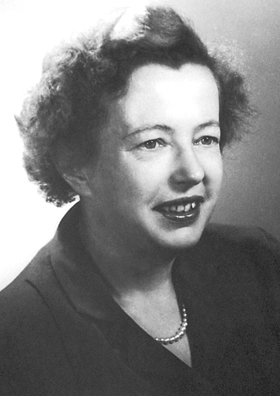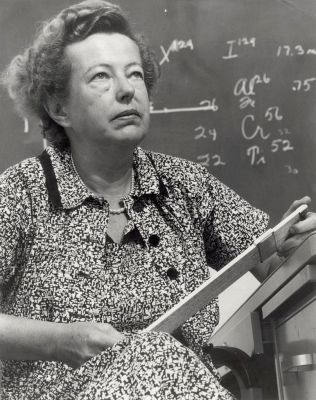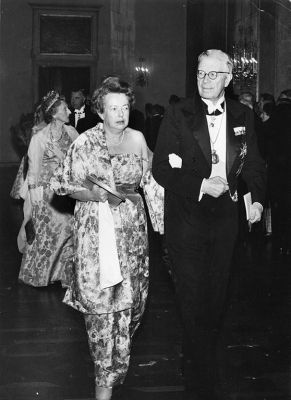Maria Goeppert-Mayer was one of only two women to win the Nobel prize for physics thus far, the other being Marie Curie. And yet her name isn’t anywhere near as well known as Marie Curie’s. She also worked on the Manhattan Project and spent time during her long career with Enrico Fermi, Max Born, Edward Teller, and many other physics luminaries.
She was “other” in another way too. She followed her husband from university to university, and due to prevailing rules against hiring both husband and wife, often had to take a non-faculty position, sometimes even with no salary. Yet being the other, or plus-one, seemed to give her what every pure scientist desires, the freedom to explore. And explore she did, widely. She was always on the cutting edge, and all the time working with the leading luminaries of physics. For a scientist, her story reads like it’s too good to be true, which is what makes it so delightful to read about.
Inevitably A Theoretical Physicist

Maria was born in 1906 in what is now Katowice, Poland, but was then Kattowitz in Germany. In 1910, her family moved to Göttingen, a university town and also in Germany. There her Father became a professor of pediatrics at the University of Göttingen, making his the sixth generation in a row to have a professor. Would Maria continue the tradition for a seventh? Time would tell.
Göttingen was the perfect location for putting her on the path to be the scientist she would become. For starters, Max Born, involved in the development of quantum mechanics and eventual Nobel prize winner for physics, was a family friend, as was David Franck, also an eventual Nobel prize winner for physics.
As a youth, her interest lay in mathematics and she entered the University of Göttingen in 1924 as a student. Many giants of mathematics were also professors at the university, including Emmy Noether, best known for Noether’s theorem. The presence of these giants attracted visitors from all over. Some of those visitors included Enrico Fermi, Paul Dirac, Arthur Holly Compton, Werner Heisenberg, John von Neumann, J. Robert Oppenheimer, Wolfgang Pauli, Linus Pauling, Leo Szilard, and Edward Teller.
It was Max Born’s influence that switched her interest from mathematics to physics. As a result of working with Max Born and David Franck her style had a mix of a strong mathematical approach to physics from the former, and a non-mathematical approach from the latter. It was also an important time for quantum mechanics, and Göttingen was a hotbed for those developments, further shaping her path.
A Masterful Thesis
By 1930, Maria had written her thesis and received her doctorate. Her thesis was a perfect culmination to her education and a foreshadowing of great things to come. It contained a theoretical treatment of two-photon processes. Many years later, Eugene Wigner, yet another Nobel prize for physics winner, would describe it as a “masterpiece of clarity and concreteness”. At the time it was not possible to test the thesis’ theoretical results experimentally. Instead that had to wait 30 years for the invention of the laser, when in 1961 her predictions would prove to be true. For her contribution, the unit for the two-photon absorption cross section was named the Goeppert-Mayer (GM). One GM is 10-50 cm4 s photon-1.
Freedom Out Of Following
As well as getting her doctorate in 1930, she married Joseph Edward Mayer, one of James Franck’s assistants. From then on she followed him wherever his own career took them, starting with an associate professor of chemistry position at Johns Hopkins University in the US, in Baltimore, Maryland.
Rules against nepotism at Johns Hopkins kept her from getting a regular appointment, but the physics department managed to arrange an assistantship which gave her access to the University’s facilities, a place to work, the freedom to join in scientific activities, and eventually the chance to give lectures to graduate students.
You might think that not having a regular appointment might have restricted her activities, but it seemed to have the opposite effect. She worked with the dean of experimentalists, and with the Mathematics Department. No one else at Johns Hopkins equalled her background in quantum mechanics and so she was able to bring it and her special mathematical background to what would later become known as the field of chemical physics, her husband’s main area of interest. She spent a few summers in Göttingen with Max Born and in 1935 published an important paper on double beta-decay, applying techniques from her thesis to a different context. In short, her lack of a regular appointment seemed to give her the freedom to spread herself out.

This pattern repeated in 1939 when she again followed her husband, this time to Columbia University in New York. Again she couldn’t be given an appointment so instead the chairman of the Physics Department gave her an office, but no salary. She became friends with Enrico Fermi who suggested she look into the valence shell structure of the as yet undiscovered transuranic elements. Using the Fermi-Thomas model of the electronic structure of the atom she correctly predicted that they’d form a new series similar to the rare earth elements.
She didn’t remain “unemployed” for long though, and took a half-time job teaching science at Sarah Lawrence College and a second job in 1942 researching separating U-235 from natural uranium as a part of the Manhattan Project. Edward Teller got her to work on the Opacity Project, related to the development of a thermonuclear weapon.
Once again the pattern repeated in 1946 when she followed her husband to The University of Chicago where there were rules against employing both husband and wife in faculty positions. There she took on a voluntary Associate Professor of Physics position which again gave her great freedom at the University. This time her path would lead all the way to the Nobel Prize.
To The Nobel Prize
Teller also moved to the University of Chicago, bringing the Opacity Project with him. This was accommodated under what would soon become the Argonne National Laboratory which was under the aegis of the new Atomic Energy Commission. There, Maria was hired as Senior Physicist, half time. Argonne was mainly concerned with nuclear physics, with which Maria didn’t have much experience but relished the opportunity to learn.

Part-timing at Argonne, she was able to continue her voluntary work with the University, some of which included activities with the Institute for Nuclear Studies. Members of the Institute included Fermi, Harold Urey, Willard Libby, Teller and even her old friend James Franck. It was an atmosphere reminiscent of the Göttingen she’d grown up in.
One of the topics under discussion at the Institute was the origin of the chemical elements. Teller asked Maria to work with him on a model for this and it was in gathering data to test the model that she made some observations that eventually lead her to think there might be stable shells in the atomic nucleus, similar to the shells of electrons in the atomic structure. After a period of further exploration, in 1950 she published her mathematical model for the structure of nuclear shells. Her model postulated that the nucleus consists of a series of closed shells with protons and neutrons paired together. She described it as follows:
“Think of a room full of waltzers. Suppose they go round the room in circles, each circle enclosed within another. Then imagine that in each circle, you can fit twice as many dancers by having one pair go clockwise and another pair go counterclockwise. Then add one more variation; all the dancers are spinning twirling round and round like tops as they circle the room, each pair both twirling and circling. But only some of those that go counterclockwise are twirling counterclockwise. The others are twirling clockwise while circling counterclockwise. The same is true of those that are dancing around clockwise: some twirl clockwise, others twirl counterclockwise.”
In 1963 she was awarded the Nobel Prize in Physics for this discovery of the nuclear shell structure. She shared the prize with two others, one of them being J. Hans D. Jensen who independently contributed to the model.
Professor Maria Goeppert-Mayer
Finally breaking the pattern in 1960, she was offered the position of Professor of Physics at the University of California at San Diego where she and her husband both took up office. She was then the seventh generation professor in her family. She stayed there where she continued pursuing physics until her death in 1972.
















Maria Skłodowska-Curie
Wow!
The two-photon absorption phenomenon isn’t just an academic exercise — it is used for 3D microfabrication as well as for certain types of fluorescence microscopy (think of those very colourful fluoresence images of neurons, etc.)
The principle is that two-photon absorption only occurs at the precise focal point of a lens, which allows for extraordinary depth selectivity in initiating chemical reactions or fluorescence processes.
Goeppert-Mayer is pretty well known in physics circles but I do agree that she doesn’t have the widespread household-name recognition of Marie Curie.
I should add that the two-photon effect needs quite powerful pulsed lasers to get it to work — and these were not commonly available until recently. They can now be found in use as turn-key devices in academic microscopy labs.
To be fair, Marie Curie won two Nobel prizes in two different fields. She remains the only person to have won Nobel prizes in multiple science fields.
xkcd 896
Great article. Thank you.
Do Émilie du Châtelet next. Do her. Do her.
She’s on the list, but won’t be next. Stay tuned!
But we’ll also totally take requests. What else you got? :)
Thanks for the great article. Just one minor typo: it says “Enciro Fermi” instead of “Enrico Fermi” the second time he is mentioned.
Best regards,
Daniel F. Larrosa
Montevideo – Uruguay
Dear Hackaday, Please add a markup or suggested edit feature to forever stop the grammar nazi comments.
People’s names aren’t grammar, comments about that are more than OK, IMHO.
Yup. As embarrassing as those typos are, we do like to fix them.
Thanks Daniel. I fixed it while your comment was still marked as Spam, so didn’t reply with thanks til now.
Thank you Steven and the rest of the staff, I’ve been enjoying HAD for many years and find it full of great material.
I’m of italian descent and admire Fermi, so the typo was easy to notice.
I’ve learnt to ignore inappropiate comments, no problem (the irony: my grandparents fought with the Partisans against the nazis in occupied Italy; they were not heroes, just two more civilians doing what they could).
I’ve recommended your article to a very respected uruguayan university math professor who fights for gender equality of opportunities and to motivate young women to follow scientific careers: https://twitter.com/janarhertz
Best regards and keep the good work.
A/P Daniel F. Larrosa
Montevideo – Uruguay
Another example of the failure of capitalism in certain fields. Money is good to motivate people to do things they don’t want to do. But for the curious and creative, the capitalist environment is non optimal, driving people in directions that simply pay the bills. Market forces are still at work, but the currency is different. In academics its not capital but prestige. In the sciences its curiosity, In creative environments, its inspiration and freedom. etc etc.
Maria Goeppert-Mayer achieved what she did because she was freed from the capitalist marketplace. Choosing what is interesting for her with total disregard of any financial returns.
Most of us have bills to pay, but unless we spend most of our energy working for the currency we value, we will not come close to our full potential. Sadly most people don’t even know what their own currency is.
The funny thing is, the only people that actually enjoy that luxury are the ones who often CBA to get a job and end up long term doing what they want whilst sapping benefits from the state and producing nothing of value except more kids to repeat the cycle.
Capitalism would say to them you do nothing you get nothing because you have no value.
Socalism says we need to give them money because…. – actually I still dont know the reason.
Yes it would be nobel to give everyone a salary to do nothing but we have already tried that experiment and most people seek Jerry Spinger and chocolate, not self worth and education.
Maria did what she wanted because she was being stipended by her husband’s salary and he was progressive enough at the time to not tell the little lady to get back into the kitchen and bring him his thinking whiskey.
She was lucky to have a man (at the time) that worked as a “capitalist pig” and could afford for her to do what she wanted whilst he paid the bills.
Reading your comment I think you are saying that Maria Goeppert-Mayer was a lucky sponger who didn’t want to work for a living. Didn’t she do well !
+1
Hell, even in the Soviet Union scientist got pay checks. But they still had to stand in line for toilet paper.
Yeah the story of Goeppert-Mayer is really interesting. She was the first person I know of to theorize about the actual physical arrangement of the so-called nucleus. Many people do not realize that the current “saturnian” model of the atom, where electrons orbit a nucleus is a recent phenomenon. For example, Gilbert Lewis put forward a static model of atoms, “the cubic atom” where stability occurs because electrons occupy each of the 8 corners as recently as 1902. J. J. Thompson put forward the “Plum Pudding” model of the atom in 1904. One interesting point is that Goeppert-Mayer’s basic framework of shells could, I think, be used to apply a static model to the atom too- where Hydrogen and Helium, Hydrogen “nuclei” (protons) and Hydrogen atoms (or “neutrons”) are stuck together. Somebody, possibly Gilbert, put forward that model- which seems logical since alpha particles are helium nuceli. One debate between Soddy and Rutherford in the early days of the “nuclear” atom theory, was if electrons were found in the nucleus, Soddy thought that beta particles, electrons, are emitted from the nucleus was evidence that electrons do exist in the nucleus. Pretty interesting stuff I think. Now people can even see atoms- and perhaps soon, even capture images from inside atoms- will we see particles orbiting like a Saturnian model, subatomic particles holding static positions, or neither or both? In any case it’s g’dim interestin!